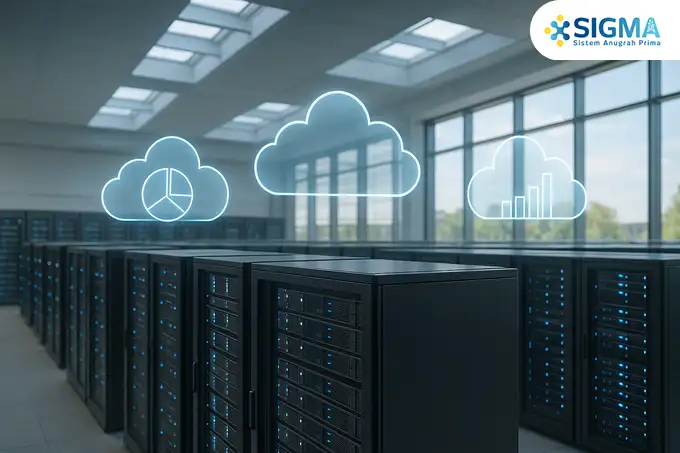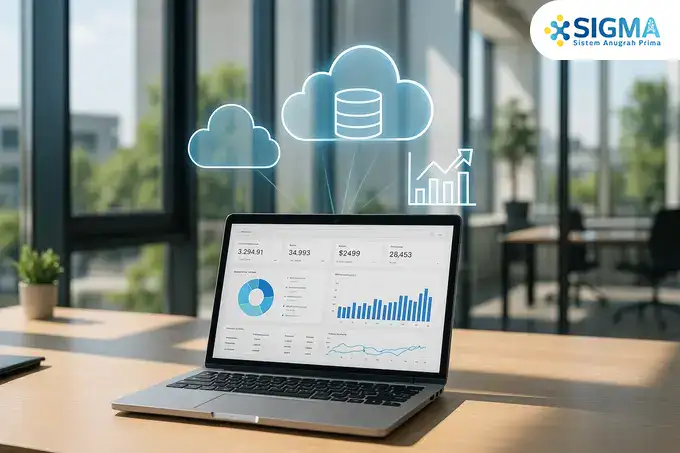SAP Cloud ERP is a cloud-based business management solution that unifies essential enterprise functions in real time. This technology empowers organizations to operate more efficiently, remain adaptable, and reduce costs compared to traditional on-premise ERP systems.
In today’s fast-paced era of digital transformation, enterprises must be agile, efficient, and responsive to dynamic market shifts. Reliance on rigid and isolated systems is no longer sustainable.
Here lies the pivotal role of Enterprise Resource Planning (ERP). Yet, a crucial question emerges: should one persist with costly physical servers or embrace a more modern solution?
The answer is found in SAP Cloud ERP, a revolutionary approach reshaping the way businesses operate. This article explores SAP Cloud ERP in depth—its definition, functionality, modules, differences from conventional systems, and why it stands as a strategic choice for businesses in Indonesia, from SMEs to large enterprises.
What is SAP Cloud ERP?
SAP Cloud ERP is SAP’s cloud-based enterprise resource planning system, enabling businesses to manage core operations—such as finance, logistics, and human resources—through the internet. This solution delivers flexibility, scalability, and real-time data access without the need for costly investments in physical server infrastructure.
In essence, instead of purchasing and maintaining servers on-site (on-premise), you “rent” ERP services hosted by SAP or its partners in secure data centers.
This represents the essence of digital transformation: shifting the burden of IT infrastructure management to the service provider, allowing companies to focus on innovation and their core business growth.
Definition of SAP Cloud ERP
The concept of cloud ERP is fundamentally a Software-as-a-Service (SaaS) model, where businesses subscribe to software instead of purchasing it outright. SAP, as a global leader in enterprise software, has adapted its flagship ERP solutions into this model to meet the demands of today’s dynamic business landscape.
SAP offers several variants of Cloud ERP, tailored to different scales and complexities of organizations:
- SAP S/4HANA Cloud: An intelligent ERP solution for mid-sized to large enterprises. Built on the in-memory SAP HANA database, S/4HANA Cloud delivers advanced analytics, artificial intelligence (AI), and automated business processes to support swift and precise decision-making.
- SAP Business One Cloud: Specially designed for small and medium-sized enterprises (SMEs). SAP Business One Cloud provides comprehensive ERP functionality—from accounting and sales to inventory management—at an affordable cost with rapid deployment.
- SAP Business ByDesign: An integrated ERP solution ideal for fast-growing mid-market companies. This platform offers a complete business suite in one package, covering finance, HR, CRM, and supply chain management.
How Does SAP Cloud ERP Work?

SAP Cloud ERP operates on a multi-tenant SaaS architecture. This means multiple customers share the same application on the provider’s servers, while each client’s data remains completely isolated and secure. This model ensures cost efficiency and seamless updates, all managed directly by SAP.
Its operation can be outlined as follows:
- Universal Access: Users can access the ERP system anytime, anywhere, using just a web browser or mobile app—without the hassle of installing complex software on each device.
- Integrated Business Modules: Data from various departments is centralized and updated in real time. For instance, when the sales team closes a deal, the system automatically updates financial records, reduces stock in the warehouse, and triggers invoicing—eliminating redundant manual input.
- Centralized, Real-Time Data: All information is stored in a unified cloud environment, ensuring everyone in the organization works with the same up-to-date data. This eliminates information silos and enhances collaboration.
Functions & Modules of SAP Cloud ERP
The true strength of SAP Cloud ERP lies in its ability to integrate diverse business functions into a single cohesive platform. Below are some of its core modules:
Finance & Accounting
- Manage general ledger, accounts payable and receivable, cash management, and fixed assets.
- Accelerate month-end closing and generate real-time financial reports.
Inventory & Supply Chain Management
- Optimize inventory levels, manage procurement processes, and track shipments with precision.
- Gain complete visibility across the entire supply chain—from suppliers to customers.
Manufacturing & Production
- Plan material requirements, manage production orders, and monitor manufacturing processes.
- Enhance production efficiency and quality control.
Human Resources & Payroll
- Administer employee data, payroll processing, talent management, and attendance tracking.
- Simplify HR workflows from recruitment to retirement.
Analytics, Reporting & Dashboards
- Provide interactive dashboards with key performance indicators (KPIs).
- Enable managers to make strategic decisions based on accurate, up-to-date analytics.
SAP Cloud ERP vs On-Premise ERP
Choosing between a cloud or on-premise model is a strategic decision. Each offers its own strengths, depending on the organization’s needs, resources, and long-term strategy.
| Aspect | SAP Cloud ERP | SAP On-Premise ERP |
|---|---|---|
| Initial Cost | Low (no server investment required) | Very High (server purchase, licenses) |
| Cost Model | Operational Expense (OPEX) – Subscription | Capital Expenditure (CAPEX) – Upfront Investment |
| Scalability | Highly flexible, easy to scale users up or down | Limited, requires additional hardware investment |
| Maintenance & Updates | Managed by provider (SAP/Partner) | Full responsibility of internal IT team |
| Physical Security | Hosted in professional data centers with strict standards | Depends on company’s own infrastructure |
| Accessibility | Accessible from anywhere with internet connection | Generally restricted to internal corporate network |
| Customization | Limited to provided configurations | Highly flexible, tailored to unique business needs |
When to Choose Cloud? SMEs and companies seeking cost efficiency, fast implementation, and remote work flexibility will benefit most from the cloud model.
When to Choose On-Premise? Organizations with strict regulatory requirements or highly specific and complex customization needs may still prefer on-premise deployment.
For a deeper understanding, read our full comparison: SAP Cloud vs On-Premise: Which is Best for You?
Advantages of Using SAP Cloud ERP

Adopting SAP Cloud ERP is not merely a technological trend, but a strategic move that delivers tangible competitive advantages.
1. Lighter Operational Costs (OPEX vs CAPEX)
The subscription model transforms heavy upfront expenditures (CAPEX) for servers and licenses into manageable operational expenses (OPEX), billed monthly or annually, making them more predictable and easier to budget.
2. Scalability Aligned with Business Growth
Your organization can seamlessly expand or reduce the number of users and functionalities as needed, without worrying about hardware capacity constraints.
3. Automatic Updates and Continuous Innovation
SAP consistently releases updates, security enhancements, and innovative features. With the cloud version, you always benefit from the latest capabilities—without the lengthy downtime associated with traditional upgrades.
4. Flexible Access Supporting Work From Anywhere
Your team can access critical business data anytime and anywhere—whether in the office, at home, or on the move—empowering hybrid and remote work models.
Who Should Use SAP Cloud ERP?
SAP Cloud ERP is designed to serve organizations of all sizes and across diverse industries, making it a remarkably adaptive solution.
- Small and Medium Enterprises (SMEs): SMEs can leverage enterprise-grade technology such as SAP Business One Cloud to automate processes, improve efficiency, and compete with larger corporations—without incurring prohibitive infrastructure costs.
- Medium to Large Enterprises: Businesses with complex operations or multiple subsidiaries across regions require the scalability and standardization offered by SAP S/4HANA Cloud to manage global operations in an integrated manner.
- Industry-Specific Needs: SAP Cloud ERP can be configured to address the unique demands of specialized industries, such as:
- Manufacturing: Real-time production tracking and efficient supply chain management.
- Distribution & Retail: Optimized inventory control, warehouse management, and omnichannel integration.
- Food & Beverage (F&B): Recipe management, expiration tracking, and regulatory compliance.
Challenges & Key Considerations

While SAP Cloud ERP offers many benefits, its adoption comes with challenges that must be carefully managed:
- Data Migration: Transferring data from legacy systems into a new ERP platform is a complex undertaking that demands meticulous planning.
- Change Management & User Training: Employees must adapt to new workflows. Effective training programs are critical to successful implementation.
- Security & Compliance: It is vital to ensure that the cloud provider complies with both local and international data security standards, such as ISO 27001.
Overcoming these challenges requires partnering with an experienced implementation provider. Learn more in our guide: The Complete Guide to Migrating to SAP Cloud ERP.
FAQ – Frequently Asked Questions
Here are some of the most common questions about SAP Cloud ERP:
Is SAP Cloud ERP the same as SAP HANA?
No. SAP HANA is a high-speed, in-memory database technology that underpins many SAP products. SAP Cloud ERP, such as S/4HANA Cloud, is an enterprise software application that operates on the SAP HANA database to deliver rapid data processing.
Is SAP Business One available in a cloud version?
Yes, indeed. SAP Business One Cloud is one of the most popular ERP solutions for SMEs, combining powerful functionality with the flexibility and affordability of the cloud model.
How long does it take to implement SAP Cloud ERP?
Implementation duration depends on business complexity. For solutions such as SAP Business One Cloud, it may range from several weeks to a few months.
For the more complex S/4HANA Cloud, implementation typically requires several months—though still faster than traditional on-premise deployments.
How secure is company data?
SAP makes substantial investments in cybersecurity. Your data is encrypted and stored in highly secure, globally certified data centers, adhering to standards such as ISO 27001. In addition, providers ensure 24/7 security monitoring.
Conclusion
SAP Cloud ERP is no longer a mere option—it has become a necessity for businesses seeking to remain relevant and competitive in the digital era. By migrating core operations to the cloud, companies can achieve new levels of efficiency, agility, and business intelligence that were once out of reach.
From agile SMEs to multinational corporations, SAP Cloud ERP provides a scalable solution designed to support and accelerate business growth.
The next step is to determine how this solution can be tailored to the unique needs of your organization.
Ready to take your business to the next level with SAP Cloud ERP?
The expert team at PT. Sistem Anugrah Prima (SIGMA) is prepared to analyze your business requirements and recommend the most suitable SAP Cloud ERP solution. Contact us today for a complimentary consultation and discover how we can become your trusted digital transformation partner.
Want to explore further? Continue your journey by reading our related articles on The Benefits of SAP Cloud ERP for Business and Key Features of SAP Cloud ERP.


